
8 minute read
Seabirds
Companion planting is an age-old tradition of organic gardening, designed to help plants grow be er, aid pollination, deter insects from munching your crops and encourage the predators that eat them. It basically involves the planting of wildfl owers or other crops alongside your main crop — think of them as li le friends or guardians, there to keep your plants happy and safe.
Most companion plants are strongly scented and therefore can deter insects in search of their host plant. Others a ract more benefi cial insects, such as ladybirds and lacewings, which then prey on aphids and other crop eaters. Some companion plants are ‘sacrifi cial’, meaning you grow them so that insects lay eggs on them instead of your prized crop. Others can benefi t the soil, such as nitrogen-fi xing legumes, which help leafy plants grow be er, or calendula, whose roots work particularly well with soil fungi, which aid the uptake of soil nutrients. All of this helps you work in harmony with nature, protect your crops and help them grow be er. What’s not to like?
On my allotment I grow calendula with tomatoes, onions and garlic with carrots and parsnips, and nasturtiums with beans and brassica crops. I also grow ne les, fennel, teasels and other wildfl owers along my allotment boundaries. These are fantastic wildlife plants, and so bring in a range of insects and birds. Ne les give me a head start on other allotmenteers: coming into leaf early in the year, ne les a ract the ne le aphid, Microlophium carnosum. This feeds only on ne les and emerges from hibernation sooner than other species, so a racts aphid predators – such as ladybirds, hoverfl ies and lacewings – early in the year. This means the predators are already on hand when the blackbean aphid starts breeding on my broad beans. Then in summer, fennel fl owers a ract hoverfl ies, which then lay eggs on aphid clusters – I rarely have a problem with aphids. Other wildfl owers a ract pollinating bees, which stay to fertilise my bean and tomato fl owers. I also like to grow caterpillar foodplants for moths and bu erfl ies because they’re nice to have around. I like to think of them as my companions, so companion planting can benefi t the gardener, too!
Kate Bradbury
is passionate about wildlifefriendly gardening and the author of Wildlife Gardening for Everyone and Everything in association with The Wildlife Trusts.
Gardens and allotments are a vital habitat for many of our struggling insects. Get tips for helping them at:
www.wildlifetrusts.org/take-action-insects
Garlic chive
Allium tuberosum
The garlicky scent from its chive-like leaves deters the carrot root fl y, which can usually smell carrots from up to a mile away.
Borage
Borago offi cinalis
Its nectar-rich fl owers a ract bees, bu erfl ies and hoverfl ies, which pollinate crops. It is also reported to improve the fl avour of strawberries.
Lavender
Lavandula angustifolia
Its strong-scented foliage can deter aphids and its fl owers a ract a range of pollinators, including bees. Plant with carrots and leeks to protect them.
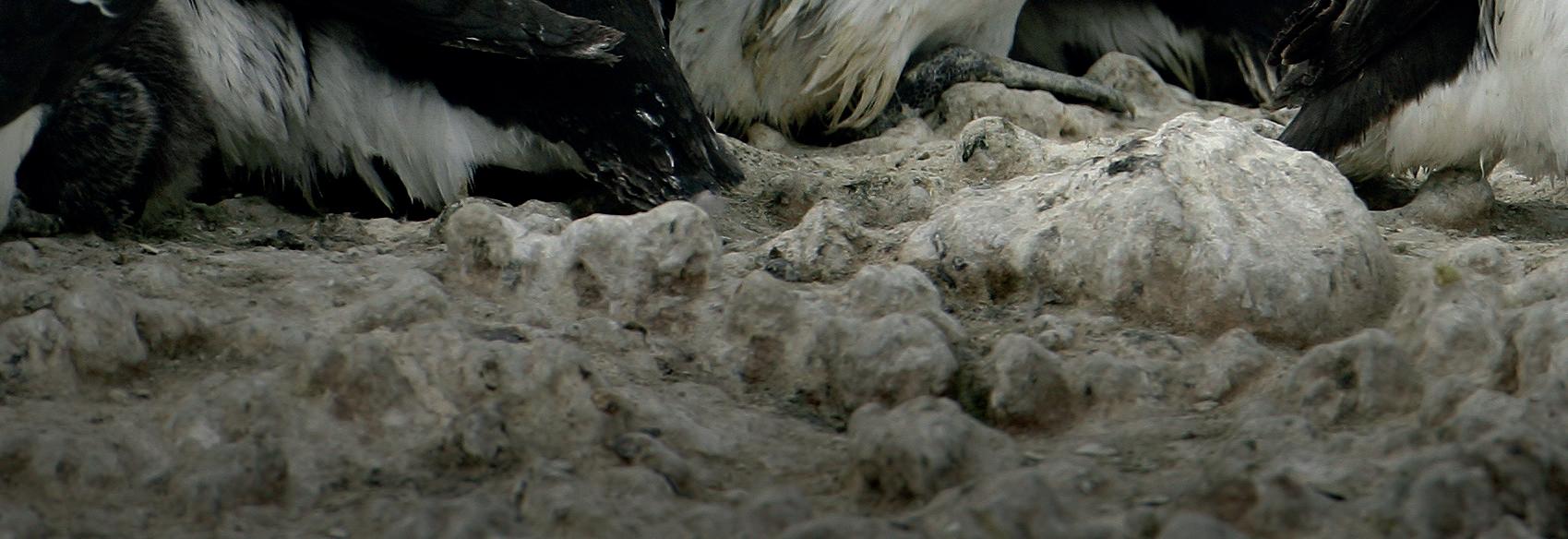


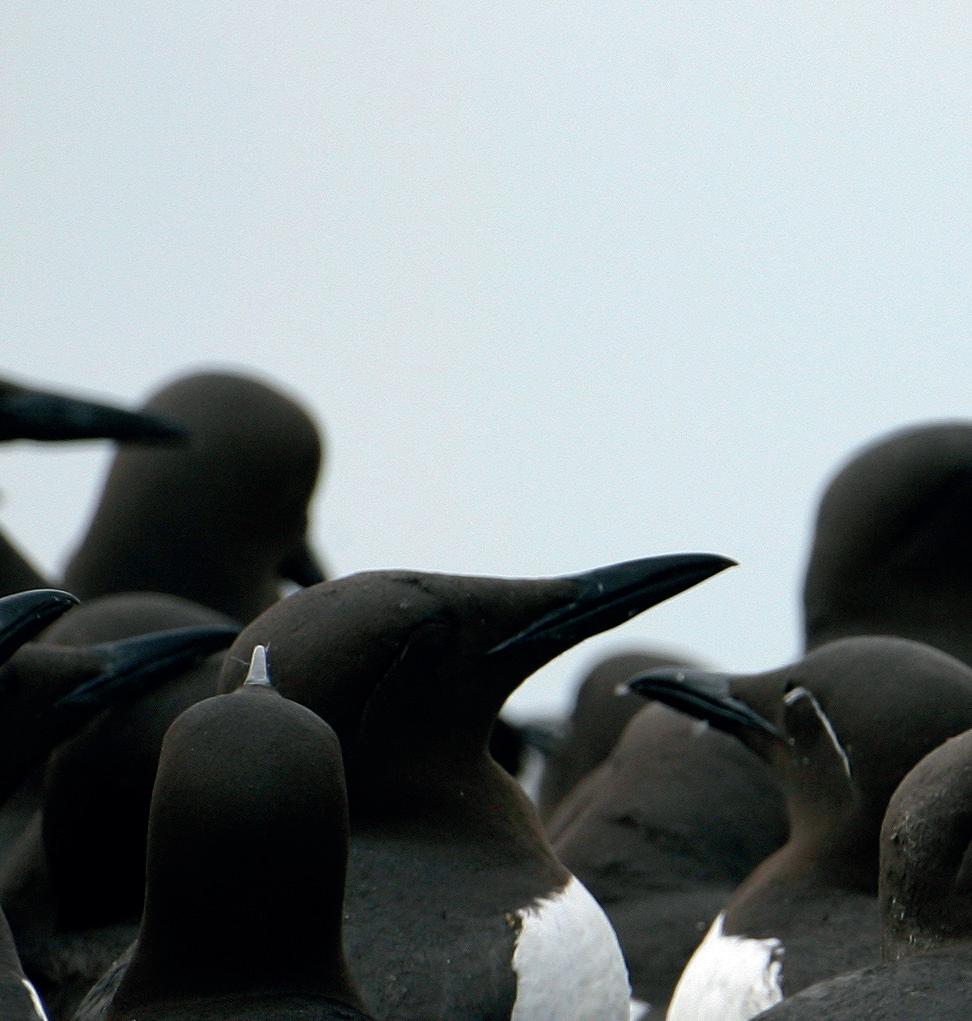
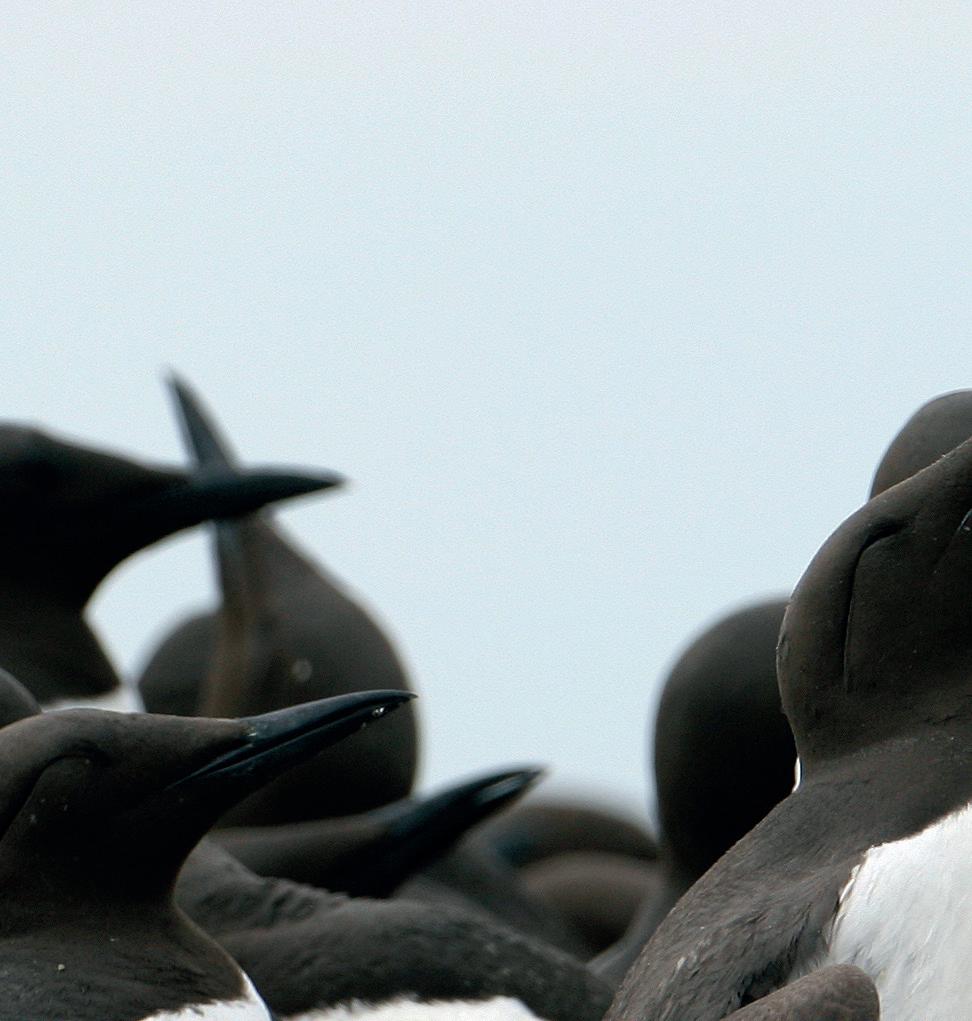




Tom Hibbert
is content o cer for The Wildlife Trusts and studies seabirds across the UK.
Guillemots nest on cli s and rocky islands, crowding together on suitable ledges.
The air is heavy with the scent of seaweed and the unmistakable musk of guano. Perched on the dry, cliff -top grass, I lean forward and cautiously peer over the edge. A heart-stopping distance below me, the North Sea washes against the algae-covered rocks. Dark shapes dot the water, with more on the white chalk cliff s. I raise my binoculars and see crowds of guillemots crammed onto the narrow ledges, their neat, almost-black-and-white plumage giving them the air of guests at an overcrowded dinner party.
One shuffl es and stretches, revealing a glorious turquoise egg tucked between its fl ipper-like feet. It leans down, studying its precious parcel, before hiding it once again in the so embrace of its feathers. The guillemots aren’t alone on their rocky home. Razorbills recline on their own li le ledges, shunning the crowds for a more private perch. Ki iwakes screech from mounds of moulded mud and seaweed, and the bright orange bill of a puffi n peeks out from the shadows of a narrow crevice.
Hundreds of birds cover the cliff s before me, with many thousands more along this single stretch of coast. The colony is in constant motion; it’s noisy, smelly, busy and without a doubt one of the most spectacular things I’ve ever seen. In a time of terrifying species declines, abundance is an increasingly diffi cult thing to experience. Rare are the bu erfl y blizzards and moth snowstorms described from just a few decades ago, but a seabird colony still off ers the chance to enjoy an overwhelming abundance of wildlife, and the UK is one of the best places in the world to discover these beguiling birds. A quarter of Europe’s breeding seabirds are found in the UK, with over eight million birds of 25 species nesting around Britain and Ireland.

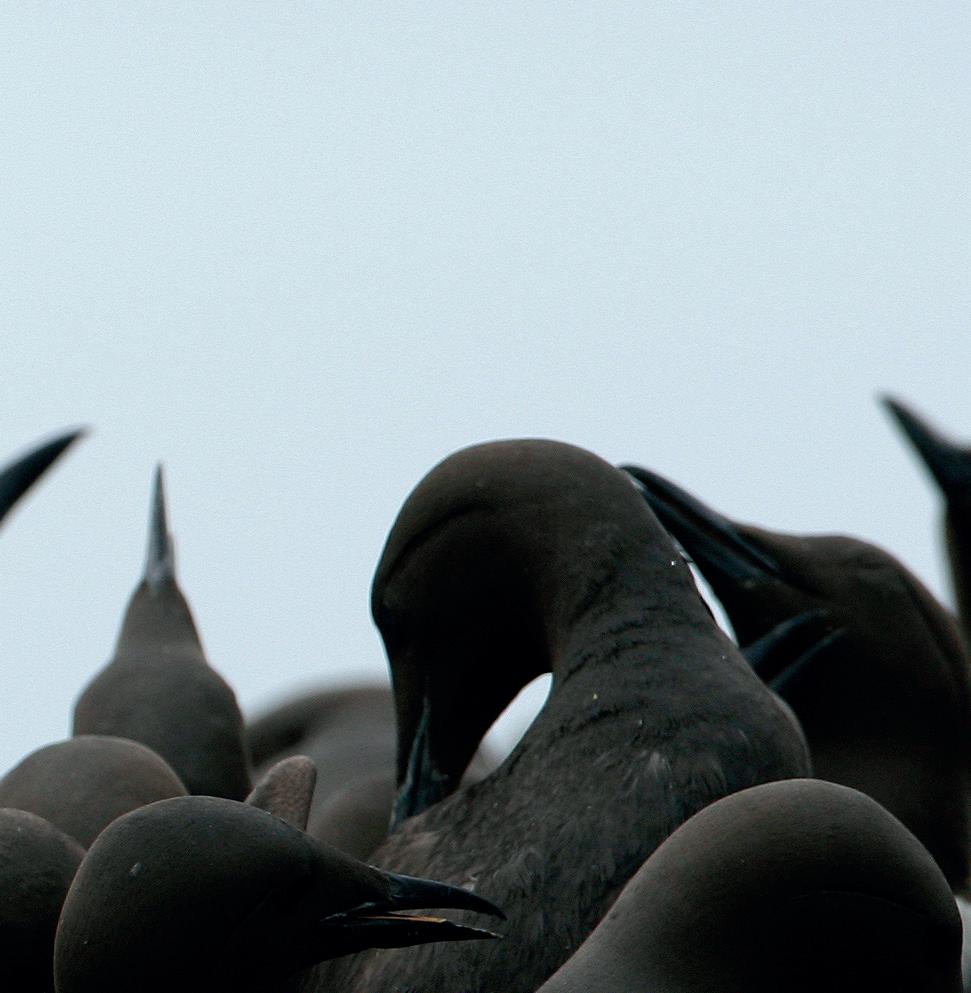
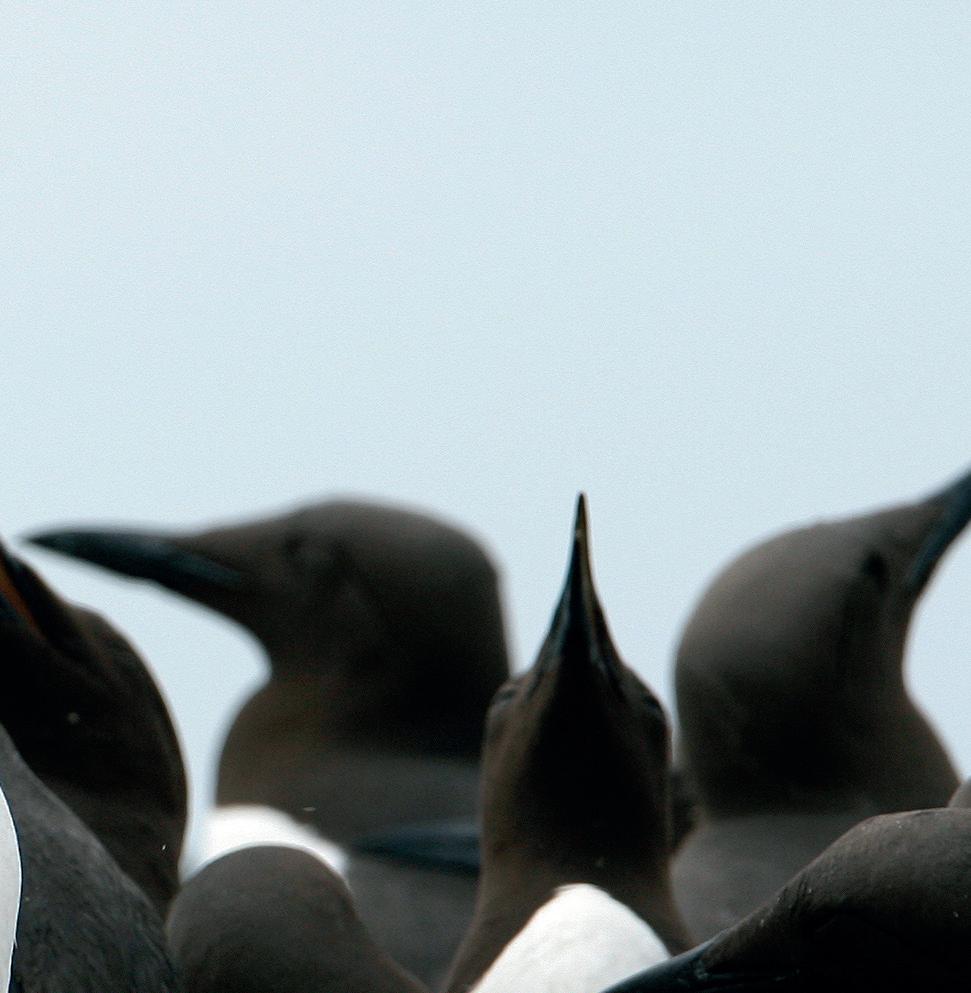


A home for the summer
Seabirds are a varied group, from the fl ightless penguins that chase fi sh through the frigid waters of Antarctica, to the globe-spanning shearwaters that cross entire oceans on their long, slender wings. They’re adventurers and explorers, taming the untameable, from wind-scoured cliff s to the endless expanse of the open ocean, thriving in the places that for so long were too hostile for us to follow. What unites these amazing animals is their unrivalled ability to be at home on land, at sea, and in most cases, in the air.
It’s on land that we know them best. No bird has truly escaped the pull of dry ground, as even the most oceangoing seabirds are tethered to land by the need to lay eggs. Every spring, our seabird cities burst into life as the summer residents return, hurriedly pair up with a new mate or reaffi rm bonds with an old fl ame, and get on with the important business of nesting.
For land loving birds, this is usually a solitary aff air, but for seabirds the opposite is true. The majority nest in colonies, sometimes hundreds of thousands strong. There are a few reasons for this, but what it really comes down to is that seabirds are at their most vulnerable when they visit land to nest. Many lay eggs on the ground, where they would be an easy snack for a hungry fox, stoat or rat. As a result, they tend to favour inaccessibly sheer cliff s or small islands off our coasts, free from the threat of mammalian predators. Prime seabird real estate like this is in short supply, so birds end up clustered together.
But even when there is room for them to spread their wings, most species cluster by choice. There’s safety in numbers. Even without the dangers of roaming mammals, there are still predators to worry about; birds of prey, crows and even other seabirds like gulls and skuas are a threat to eggs, chicks and adults. Nesting in numbers is the best defence.
For some it’s about protection. Arctic terns are ferociously dedicated parents and will defend their nest from any potential predator that gets too close, plunging and pecking at people, gulls and even polar bears. One angry bird is a nuisance, dozens or even hundreds together make a very eff ective deterrent. For other species it’s all about the odds — the more nests there are around you, the less likely yours is to be targeted.
Some of our smaller seabirds keep their eggs and young safe by nesting underground. Puffi ns, arguably the UK’s most popular seabird, deposit their single egg deep within a rocky crevice, or at the end of a burrow dug into a grassy slope. Pairs can dig their own burrows, but they’ll also steal them from rabbits and Manx shearwaters, secretive seabirds that return to their nests under cover of darkness.

Land-locked seabirds
You’d be forgiven for thinking that to see a seabird, you have to travel to the coast. A er all, sea is in their name. But some seabirds have taken to inland waterways, nesting on lakes, reservoirs and even the roofs and ledges of buildings. Ki iwakes, dainty gulls with black legs and a bright yellow beak, can be heard giving their evocative cry of ‘ki -eeee-waark’ above the Newcastle-Gateshead Quayside each summer. At around 13 kilometres from the sea, this is the most inland ki iwake colony in the world, but some seabirds have put even more distance between themselves and the coast.
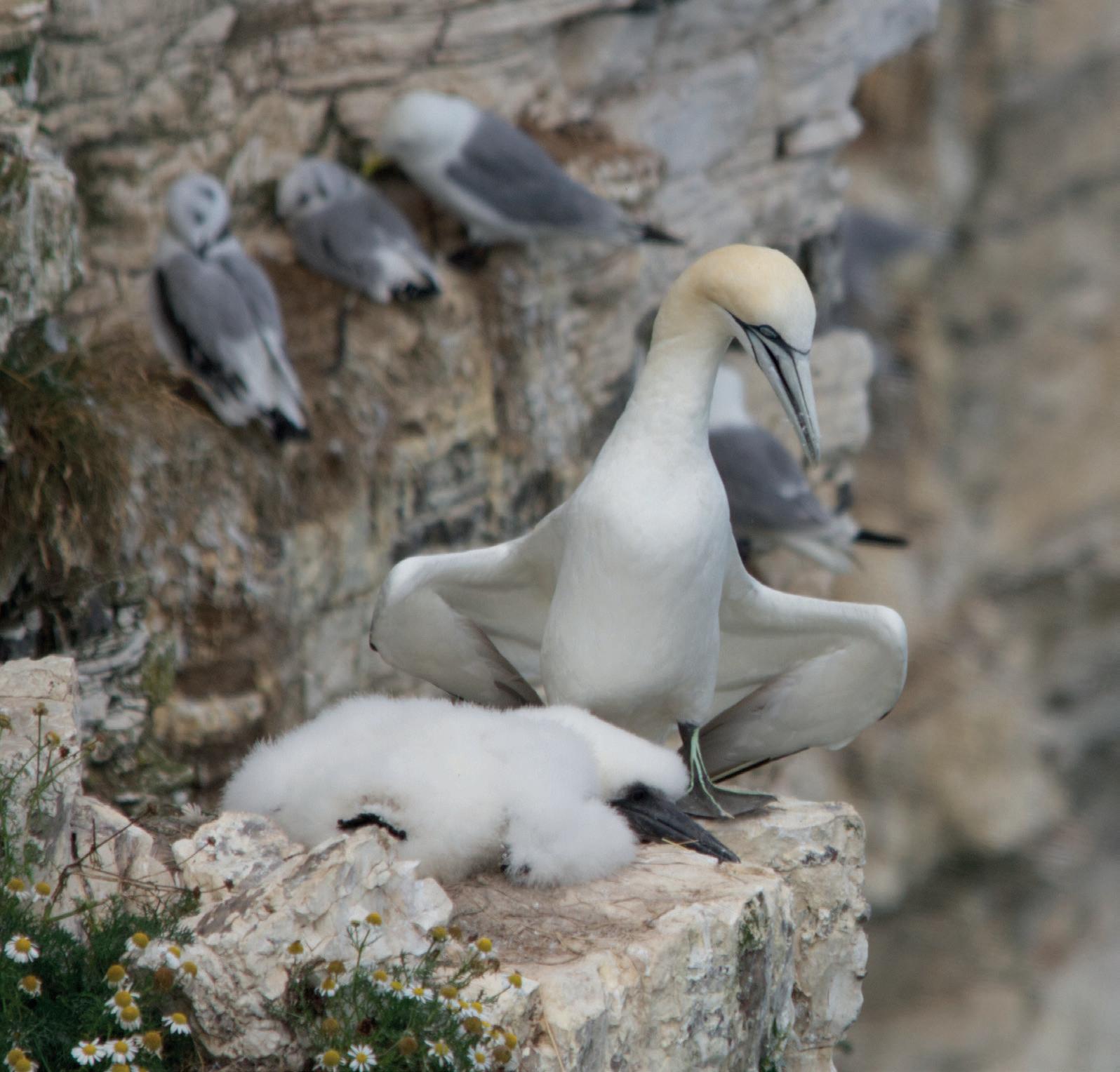
TOM HIBBERT
Manx shearwaters complete a 7,000mile journey in less than a fortnight.
The UK is home to 55% of the world’s population of northern gannets.
Arctic terns have the longest known migration of any animal, with some travelling over 59,000 miles a year.
Gannets plunge into the water from heights of 30m, reaching speeds of up to 60mph.
Guillemots have been recorded diving to depths of 180m in pursuit of sh.






